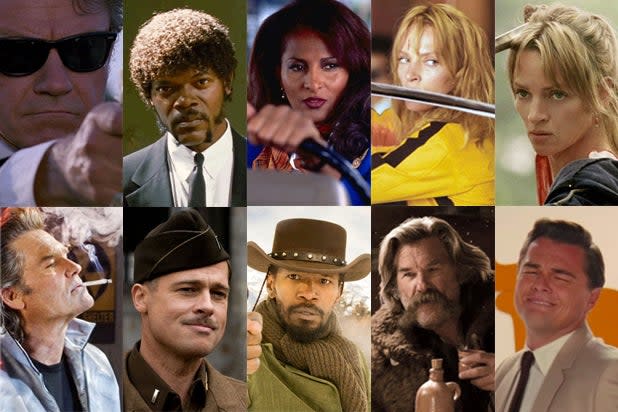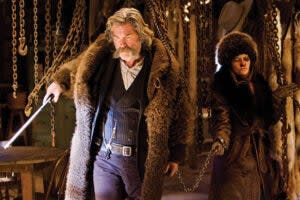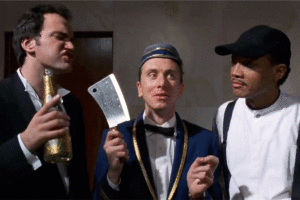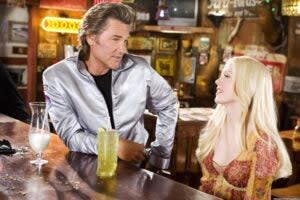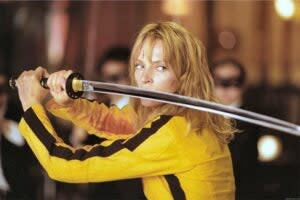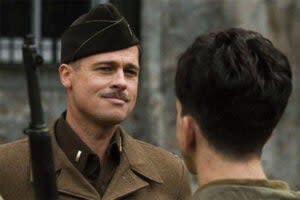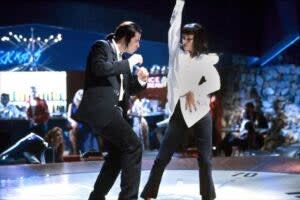Every Quentin Tarantino Film Ranked From Worst to Best (Photos)
- Oops!Something went wrong.Please try again later.
- Oops!Something went wrong.Please try again later.
There are few modern filmmakers with a voice as distinctive as Quentin Tarantino’s, a former video-store clerk who transformed his movie love into blockbuster, arthouse, genre-redefining masterpieces that kept grindhouse cinema alive while pushing nostalgia in bold directions.
With a career spanning 27 years and ten feature films (depending on how you count), Tarantino has made an indelible mark on cinema. And his hard-hitting, playful directorial style has, in all that time, made good films great, great films classics, and the faults in bad films sometimes harder to recognize.
Here, then, are Quentin Tarantino’s films from “Reservoir Dogs” to “Once Upon a Time in … Hollywood,” ranked from the very worst to the very, very best:
10. “Once Upon a Time in … Hollywood” (2019)
Sharon Tate is a meaningless footnote in her own life story in Quentin Tarantino’s baffling and insulting ode to 1960s Hollywood. Tate is played by Margot Robbie, who is criminally underutilized, and takes a backseat to a fictional, mediocre actor played by Leonardo DiCaprio and his stunt double, played by Brad Pitt. They worry about their careers and mock Bruce Lee for two hours, until the film builds to a cruel, misogynistic Manson Family climax that finally reveals the true reason the film exists: to be a shameless self-insert fantasy. “Once Upon a Time in … Hollywood” is far and away Tarantino’s most immature motion picture, a non-stop nostalgia fetish parade with no demonstrable respect for the real-life tragedies it portrays.
9. “The Hateful Eight” (2015)
Quentin Tarantino’s 70mm one-location parlor mystery is chockablock with excellent performances and his signature, sparkling dialogue. But he seems all-too-eager to exploit the horrors of hatred and all-too-reticent to come to any meaningful conclusions about them. “The Hateful Eight” is a gruesome story about despicable human beings, trapped in a Wild West rest stop, whose lifetimes of violence catch up with them over the course of an evening. The dynamite ensemble — Samuel L. Jackson, Kurt Russell, Jennifer Jason Leigh, Bruce Dern, et al — makes a meal of the screenplay, but in the end all we’re left with is a disappointing and mean-spirited punchline, which argues that the only way men can overcome their racism is to find common ground in their misogyny.
8. “Kill Bill: Vol. 2” (2004)
The second installment of Tarantino’s “Kill Bill” — which was released theatrically in two parts, so that’s how we’ll review it — is gutsier than the first, but also less cohesive. The Bride (Uma Thurman) continues her roaring rampage of revenge with increasingly episodic adventures, as she fights her one-eyed nemesis Elle (Daryl Hannah) and Bill’s brother Bud (Michael Madsen). But after the bravura finale of “Vol. 1,” the momentum never picks up again, and we’re stuck watching digressive subplots about menial strip-club maintenance and flimsy excuses for Michael Parks play multiple roles. A few great battles, a memorable flashback training sequence with the iconic Gordon Liu, and David Carradine’s greatest (albeit short) performance make it worth watching, but it’s hard to deny that Tarantino simply front-loaded his two-part grindhouse homage.
7 1/2. “The Man From Hollywood” from “Four Rooms” (1995)
The oft-overlooked anthology comedy “Four Rooms” features humorous vignettes from Allison Anders, Alexandre Rockwell, Robert Rodriguez and (obviously) Tarantino. Although the installments are hit-and-miss (Rodriguez’s is the best), Tarantino’s “The Man from Hollywood” is a deft little experiment in suspense. Tim Roth plays a hapless bellboy who’s enlisted to chop off someone’s finger if, as Tarantino himself explains at length, they can’t get a Zippo lighter to ignite ten times in a row. It’s an awful lot of build-up for a delectably amusing finale, subverting the Hitchcockian concept of cinematic tension in favor of whimsical, unexpected realism.
7. “Death Proof” (2007)
Quentin Tarantino and Robert Rodriguez each directed a 1970s throwback for “Grindhouse,” a double-feature event which also featured trailers by Edgar Wright and Rob Zombie. But unlike Rodriguez’s “Planet Terror,” which was bigger and crazier than its source material, Tarantino’s “Death Proof” accurately recreates the low-budget, talky aesthetic of films that could only afford to have two cool set pieces. The story of Stuntman Mike (Kurt Russell), a misogynist who kills women with his specially modified car, gets lost in its own dialogue but features one of the greatest car chases ever filmed, with stunt legend Zoe Bell, playing herself, strapped to the hood of a car most of the time. However, in light of the behind-the-scenes events of “Kill Bill,” which are uncomfortably reminiscent of the events of “Death Proof,” the film ultimately feels comes across more creepy (in a bad way) than thrilling.
6. “Reservoir Dogs” (1992)
Tarantino’s first (finished) feature is a heist film where we never see the heist, and instead flash back and forth between the planning stages and the tragic aftermath, where almost everyone is dead and nobody knows who’s responsible. Although it’s very similar to Ringo Lam’s “City on Fire,” the film became a statement of purpose for Tarantino, establishing his vision of a criminal underworld full of chatty, violent, macho posturers who aren’t nearly as cool, or as bulletproof, as they think they are. Harvey Keitel, Tim Roth, Steve Buscemi and Michael Madsen give iconic performances in this smart, low-budget ensemble thriller.
5. “Django Unchained” (2012)
The Oscar-winning western “Django Unchained” takes the racist dialogue Tarantino frequently writes, gives it to horrible people, and then lets Jamie Foxx brutally murder them. Foxx plays the title character, a freed slave turned bounty hunter who teams up with mentor Dr. King Schulz (Christoph Waltz) to rescue Django’s wife Broomhilda (Kerry Washington) from a monstrously hateful southern dandy, Calvin Candie (Leonardo DiCaprio). The grindhouse story structure helps Tarantino’s sprawling saga of violent justice stay focused, and the wall-to-wall excellent performances help elevate the material further. One of Tarantino’s most satisfying films.
4. “Kill Bill: Vol. 1” (2003)
Uma Thurman’s quest for stylish, violent vengeance begins in a breathless action movie, filled with fantastic fight choreography, unforgettable set pieces and fascinating characters. Although the story doesn’t conclude until later, and “Kill Bill: Vol. 1” ends on a cliffhanger, the film feels impressively complete. It’s every awesome 1970s movie mashed together, bound by an infectious love for the medium. Tarantino seems desperate to push every disparate, underappreciated genre to its artistic and technical limits, and his love for his source material is infectious.
3. “Inglourious Basterds” (2009)
Tarantino takes a chainsaw to history in this rousing, fascinating World War II drama. Mélanie Laurent stars as the Jewish owner of a movie house in Paris, who plans to assassinate Hitler when he attends the premiere of a new Nazi propaganda film. Meanwhile, Brad Pitt and his ragtag band of Jewish soldiers are taking Nazi scalps behind enemy lines, and the mesmerically evil Hans Landa (Oscar-winner Christoph Waltz) tries to play them all for suckers. Unlike the insulting “Once Upon a Time in … Hollywood,” the historical revisionism in “Inglourious Basterds” comes across as empowering, celebrating the heroic power of cinema and giving WWII an unexpectedly cathartic — though highly implausible — Hollywood climax.
2. “Pulp Fiction” (1994)
The second film from Quentin Tarantino solidified the filmmaker’s distinctive storytelling style and ushered in a torrential wave of imitators, making films full of fast-talking, pop culture-savvy criminals. “Pulp Fiction” did it best, and this series of interconnected stories (about ill-fated hitmen, an ill-fated boxer, and an ill-fated gangster’s wife) doesn’t feel like an empty style exercise. It’s as though Tarantino and co-writer Roger Avery tore away the artifice of genre cinema and forced all the archetypal characters to reveal their previously unexplored humanity. Crime was no longer alluring and mysterious, it was everyday and familiar, and — surprise! — we love it that way. “Pulp Fiction” reintroduced the moviegoing community to crime cinema, and neither the community nor the medium have been the same since.
1. “Jackie Brown” (1997)
Tarantino’s films have always been about exposing the hidden depths in seemingly shallow cinema, but when he finally had a story with actual depth — courtesy of Elmore Leonard, on whose novel “Rum Punch” this was based — he knew enough to let it ride. Pam Grier gives an all-time great performance as a flight attendant caught between a smuggler, an ATF agent and an amorous bail bondsman. Her chemistry with Oscar-nominee Robert Forster is genuine and rich, and Samuel L. Jackson’s performance as a criminal who refuses to admit he’s not a mastermind is unpredictable and unforgettable. Meanwhile, Tarantino’s deft direction lifts the multi-perspective racetrack centerpiece from Stanley Kubrick’s “The Killing,” infusing Leonard’s story with his own distinctive preoccupations. “Jackie Brown” is Tarantino’s smartest, his most earnest and — in a subtle way (rarely the auteur’s strong suit) — his most beautiful motion picture to date.
